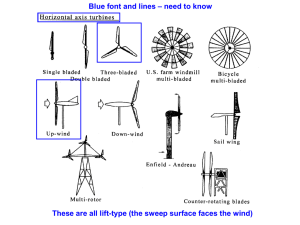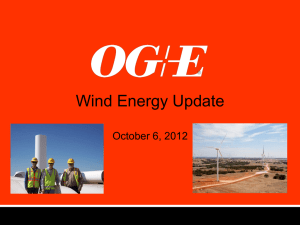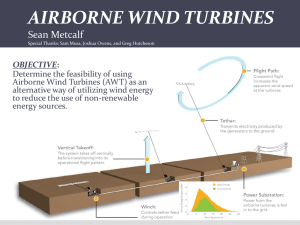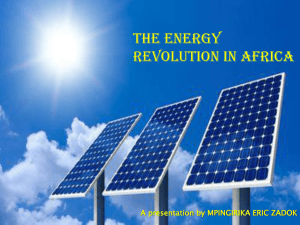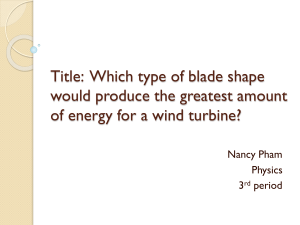Wind Turbine
advertisement
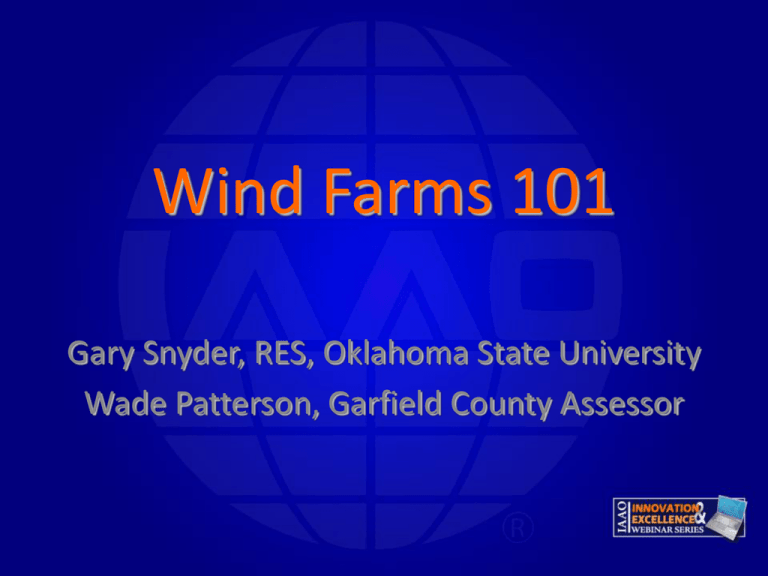
Wind Farms 101 Gary Snyder, RES, Oklahoma State University Wade Patterson, Garfield County Assessor What is wind energy and how is it generated? Wind energy is a source of renewable energy that harnesses the kinetic energy of the wind or, in other words, of the air in movement. Once transformed to mechanical energy, wind energy can be used for various applications (windmills to pump water or grind cereals). The most common use nowadays is to generate electricity using wind turbines. Picture of new and old “wind mills” How do wind turbines work? The wind’s kinetic energy is transformed into electricity by wind turbines. These are made up of a tower, a gondola comprising a rotor and an anemometer (measures wind speed), a weather vane or “weathercock” to indicate wind directions and a lightning conductor. Wind turbine diagram expanded Source: Way2Science How do wind turbines work? A Rotor is composed of the blades and an axle, attached to each other by a bearing, this allows for the pitch of the blade to be adjusted. The blades, moved by the wind, transmit force to the low speed shaft, which is connected to a multiplier (gearbox) that increases the axle speed. The mechanical energy is transferred from the multiplier to an electricity generator, which transforms it into electricity for subsequent injection into the grid. Source: AWEA Basic diagram of a wind turbine How do wind turbines work? The range of wind turbine power goes from 100 W with a blade diameter of around 1 meter, which are mainly used for residential purposes, to about 5 MW (5,000,000 watts) with a blade diameter and tower height greater than 100 meters. 400 Watt Turbine 600 Watt Turbine One 1.6 MW turbine will provide enough power for 500 typical homes 1.8 Megawatt Turbine, or the equivalent of 4,500 small 400 Watt turbines Definitions • Renewable Energy - Energy derived from resources that are regenerative or that cannot be depleted. Types of renewable energy resources include wind, solar, biomass, geothermal, and moving water. • Grid (also “Power Grid” and “Utility Grid”) - A common term referring to an electricity transmission and distribution system. • Wind Turbine - A term used for a wind energy conversion device that produces electricity. Definitions • Generator - A device for converting mechanical energy to electrical energy. • Met Tower - Meteorological towers erected to verify the wind resource found within a certain area of land. • Nacelle - The cover for the gearbox, drive train, and generator of a wind turbine. • Rotor - The blades and other rotating components of a wind energy conversion turbine . Definitions • Watt (W) - The rate of energy transfer (from an outlet to an appliance, for example). Wattage is calculated by multiplying voltage by current. • Kilowatt (kW) - A standard unit of electrical power equal to 1,000 watts. • Megawatt (MW) - The standard measure of electric power plant generating capacity. One megawatt is equal to one thousand kilowatts or 1 million watts. • Gigawatt (GW) - A unit of power equal to 1 million kilowatts. Definitions • Capacity Factor - The amount of power a turbine actually produces over a period of time divided by the amount of power it could have produced if it had run at its full rated capacity over that time period. • Specific Yield - Measurement of the annual energy output per square meter of area swept by the turbine blades as they rotate. • Rated Power Output - Used by wind generator manufacturers to provide a baseline for measuring performance. Rated output may vary by manufacturer. • Rated Wind Speed - The wind speed at which the turbine is producing its nameplate-rated power production. For most small wind turbines this is around 30 to 35 miles per hour. Definitions • Start-Up - The wind speed at which a wind turbine rotor starts to rotate. It does not necessarily produce any power until it reaches cut-in speed. • Cut-In-Speed - The rotational speed at which an alternator or generator starts pushing electricity hard enough (has a high enough voltage) to make electricity flow in a circuit. • Cut-Out Speed - The wind speed at which the turbine automatically stops the blades from turning and rotates out of the wind to avoid damage to the turbine. Definitions • Power curve - The instantaneous power output of a specific turbine design at various wind speeds. Used with wind resource data to determine the potential for electricity generation at a project site. • Furling - The act of a wind generator Yawing out of the wind either horizontally or vertically to protect itself from high wind speeds. • Yaw - Rotation parallel to the ground. A wind generator Yaws to face winds coming from different directions. Wind farms It is normal practice, to group wind turbines together within wind farms to harness the maximum wind force and obtain greater quantities of energy. The turbines are separated from each other in these parks by a minimum distance of three times the diameter of the rotor and a maximum of nine times this diameter, in order to avoid wind turbulence and make it easier to connect the wind turbines to the electricity grid. Wind turbine turbulence Wind farms When evaluating a potential wind farm site, the ground conditions have to be taken into account, such as unevenness, the existence of obstacles and the area's orography (the study of the formation and relief of mountains), so that the best return possible is achieved. Uneven ground reduces wind speed, while obstacles such as trees, buildings, and outcrops cause turbulence, which has a negative effect on the wind harnessed for electricity generation. These factors also cause wind turbines to wear faster. Wind farms Making good use of an area’s orography can have advantages and result in improved performance. Thus, a good option is to position turbines in “tunnels” between, for example, two rock outcrops, where the wind speed is greater. Wind farms are also frequently installed on hilltops since the wind speed is greater at higher altitudes. Wind turbines at Blue Canyon Wind Farm, SW Oklahoma Wind turbines at Blue Canyon Wind Farm, SW Oklahoma The Production Tax Credit (PTC) --American wind power's key federal incentive (the 2.2 cents per kilowatt-hour Production Tax Credit, or PTC) only applies to projects that succeed in putting electricity on the grid. It will expire Dec. 31, 2012, unless Congress extends it. --The PTC has not been allowed to expire since 2005, when President George W. Bush extended it as part of the Energy Policy Act. --This successful policy over the past several years has incentivized $15.5 billion a year on average in private investment in the United States. Wind facilities account for 35% of all new energy production capacity (measured in megawatts) in the United States. This is a close second to natural gas. Source: AWEA The Production Tax Credit (PTC) The PTC, the main policy tool in the deployment of U.S. wind power, was first adopted during the administration of President George H.W. Bush as part of the Energy Policy Act of 1992 (P.L. 102-486). It has been a significant driver of the recent growth of the U.S. wind industry. In each of the years during which the PTC lapsed (2000, 2002, and 2004), meaning that it expired prior to being renewed, the level of additional deployed wind capacity slowed or collapsed when compared to the previous year’s total: 93% in 2000, 73% in 2002, and 77% in 2004 History of new wind production capacity in relation to the Production Tax Credit (AWEA) The wind energy Production Tax Credit Congress provided a three-year extension of the PTC through December 31, 2012, as part of the American Recovery and Reinvestment Act. The PTC provides an inflation-adjusted per kilowatt-hour (kWh) income tax benefit over the first ten years of a wind project’s operations, which in 2010 was 2.2 cents per kWh, and is a critical factor in financing new wind farms. In order to qualify, a wind farm must be completed and start generating power while the credit is in place, which would be by the end of 2012. National Renewable Energy Laboratory Innovation for Our Energy Future Notice the huge increase in wind production from the slide showing 1999 production! How a wind farm is developed Find a windy site. Look for sites where the average wind speed is appropriate for the turbines to be used. Make sure the site has nearby transmission lines. It’s not enough to find wind. There has to be a way to transport the electricity generated by a wind farm to a main power grid. Define the boundaries. After you find a windy place that’s near a power grid, define the boundaries of the prospect area. (North American Electric Reliability Corporation) Northeast Power Coordinating Council Midwest Reliability Organization Reliability First Corporation Western Electricity Coordinating Council Southwest Power Pool SERC Reliability Corporation ERCOT Electric Reliability Council of Texas Florida Reliability Coordinating Council By: TheWINDCOALITION How a wind farm is developed Determine who owns the land within the prospect boundaries. The owners of the land within the prospect boundaries are potential partners. Contact the landowners. In order to gauge interest in wind farm development, the wind energy company contacts the landowners about the possibility of a partnership. Call a town meeting. If there are many landowners in the same area, a town meeting helps explain the ins and outs of wind farm royalty payments and natural resource management. How a wind farm is developed Settle the contracts. A company and the landowners will negotiate agreements for test towers and options for lease agreements. Create blueprints. The company lays out potential wind farm configurations to give landowners an idea of where the turbines might be placed. Watch the wind. A company typically monitors the wind for 6 months to 2 years to corroborate their data with publicly available wind data. How a wind farm is developed Get the necessary permits. While testing the wind’s power, the company is also acquiring the necessary permits at the federal, state, and county levels. Perform environmental analyses. The company is required to ensure the safety of local wildlife and the environment. Test the wires. Testing grid connections is very important. Companies will perform additional transmission research. How a wind farm is developed Sell the electricity. Selling wind generated electricity is the “Holy Grail” in the business. Most wind energy companies cannot build a project until a customer is found. Because of the huge upfront cost, projects are feasible only after a customer, such as a large utility, has committed to a long-term energy purchase (power purchase agreement or PPA) of 10 to 20 years in duration. How a wind farm is developed Begin construction. The construction phase usually takes about 9 months to a year. Work with landowners to minimize disturbance to the land. The company will build roads and erect turbines. The company will establish the electrical and engineering work to connect the turbines to the grid. Wind turbines and access roads occupy less than 3% of the land in a typical wind farm. Electricity distribution diagram What are the components of a wind farm? Meteorological (Met) tower Met tower being constructed 80 meter met tower, approximately 265’ Turbine base pad excavation Turbine base sub-frame Pouring concrete for the base Installing conduit for lines Completed tower base, ready for a tower Tower lay down site Installation of the bottom section of the tower Installation of the middle section of the tower Final adjustments Second section weight Maneuvering the a section of the tower into place Nerves of steel! View from inside the tower Top 10 wind turbine manufacturers by annual market share (installed capacity) in 2011 by IHS Inc. Vestas Sinovel Goldwind Gamesa Enercon GE Wind Energy Suzlon Group Guodian United Power Siemens Wind Power Ming Yang Source;: Wikipedia 12.7% 9.0% 8.7% 8.0% 7.8% 7.7% 7.6% 7.4% 6.3% 3.6% Nacelle and hub lay down site Close-up of the nacelle Starting to connect the nacelle and the hub Connecting the nacelle and the hub Final adjustments before nacelle and hub are connected Easy does it! Lifting the nacelle into place Lifting the nacelle to the top of the tower Nacelle installation Attaching the nacelle to the tower Blade lay down yard Blade being transported to the tower site In-air blade installation In-air blade installation In-air blade final attachment to the hub Assembled blade and hub being lifted into place Installed blade and hub Tower base and access door Completed tower Every tower will have a connection box Trench for the interconnect lines Wind farm substation Completed wind turbine and pad site Aerial view of a wind farm Aerial view of a wind farm View of the inside of the nacelle Removing the “internal organs” of the nacelle Picture of a “climbing crane” Image: © VESTAS WIND SYSTEMS A/S Image: © VESTAS WIND SYSTEMS A/S Chisholm View Wind Project Project Location: The Chisholm View Wind Project is located approximately 15 miles North and East of Enid, Oklahoma and directly adjacent to Hunter, OK. The project sits within Garfield and Grant Counties. Wind Power Classes Wind Power Class 10 meter 50 meter Wind Power density Speed m/s (mph) Wind Power Density Wind Speed m/s (mph) 1 0 0 0 0 2 100 - 150 4.4 (9.8) / 5.11 (11.5) 200 - 300 5.6 (12.5) / 6.4 (14.3) 3 150 - 200 5.1 (11.5) / 5.6 (12.5) 300 - 400 6.4 (14.3) / 7.0 (15.7) 4 200 - 250 5.6 (12.5) / 6.0 (13.4) 400 - 500 7.0 (15.7) / (16.8) 5 250 - 300 6.0 (13.4)/6.4 (14.3) 500 - 600 7.5 (16.8)/8.0 (17.9) 6 300 - 400 6.4 (14.3)/7.0 (15.7) 600 - 800 8.0 (17.9)/8.8 (19.7) >8.8 (19.7) 7 >400 >7.0 (15.7) >800 Wind rating for Oklahoma Chisholm View Chisholm View Chisholm View Wind Farm, Garfield Co. OK Close-up of Chisholm View Chisholm View Wind Project Project Interconnection: An existing 345kv line owned by Oklahoma Gas & Electric runs through the project site. Chisholm View will interconnect directly onto this line and have the ability to deliver energy South to load centers such as Oklahoma City and North to load centers in and around Wichita, KS. Chisholm View Wind Project Project Size: 235 MW (140 Turbines) Project Turbines: GE 1.6 MW Landowners and Acreage Involved: Chisholm View encompasses approximately 45,000 acres and involves over 150 landowners. Chisholm View Wind Project Utility Buyers: The power produced by Chisholm View (located in the SPP grid region) will be sold to Alabama Power Company, a subsidiary of Atlanta-based Southern Company. (located in the SERC grid region) The Chisholm View Wind Project will deliver clean, low cost electricity to communities in Alabama. (North American Electric Reliability Corporation) Northeast Power Coordinating Council Midwest Reliability Organization Reliability First Corporation Western Electricity Coordinating Council Southwest Power Pool SERC Reliability Corporation ERCOT Electric Reliability Council of Texas Florida Reliability Coordinating Council By: TheWINDCOALITION Chisholm View Wind Project Key Project Attributes: A 235 MW Chisholm View Wind Project would produce enough power for approximately 80,000 Alabama homes. The project will take only approximately 1-2 percent of land out of service to build, including all land for roads, turbine foundations, and maintenance buildings. Chisholm View is one of the most energetic wind development sites in North Central Oklahoma. Chisholm View Wind Project Key Project Attributes continued: Once fully developed, Chisholm View Wind project will contribute up to $5 million per year in total annual landowner payments. The project enjoys broad community support from landowners and local government agencies. The project is expected to have no material effect on any threatened and endangered species of birds or animals based on third party studies commissioned by TradeWind Energy. Road Maintenance Agreement Overview “Primary Roads” are identified – i.e. major construction traffic corridors Designation of condition and/or type of road Site plan is approved by county as part of agreement County authorizes project’s use and improvement of said roads Counties waive weight restrictions in return for payment and/or upgrade/repair obligations Road Maintenance Agreement Overview County to continue routine maintenance during construction Project agrees to specific payments due and/or upgrade and restoration obligations and specs Culverts and bridges needing replacement or repair are identified County allows Project to make routine improvements and initiate routine maintenance of Primary roads at its own expense County authorizes crane crossing of ROW, increasing radiuses of intersections, etc Permitting Requirements Chisholm View Wind Project Environmental Studies Completed Avian Migration, Raptor Migration, Raptor Nest, Bat Monitoring, Cultural Resources, Wetlands, Threatened and Endangered Species Habitat Assessment, Phase I Environmental Site Assessment, Microwave Beam Path, TV, AM/FM Site Prospecting and Selection Q1 2008 Interconnection Feasibility Request Filed (SPP) Q1 2008 Assessor Supplied GIS Ownership Q1 2008 Begin Contacting Landowners to Gauge Interest Q1 2008 Met Tower Installation (1st of many) Q1 2008 Initiate Land Leasing Campaign Q2 2008 Conduct Town Hall Meetings (1st of many) Q2 2008 Initial Field Environmental Surveys Q1 2009 Continue Environmental Surveys, Wind Data Collection, Leasing, PR all 2009 Initiate Power Marketing Efforts 2009 Land Leasing Substantially Complete Q1 2010 Generator Interconnection Agreement Executed (SPP) Q3 2010 Continue Environmental Surveys, Wind Data Collection, Leasing, PR all 2010 Power Purchase Agreement Executed Q3 2011 Initiate Permitting Q3 2011 Initiate Final Engineering Q3 2011 Procure Major Equipment Q4 2011 Complete Road Maintenance Agreement w/ County Q1 2012 Permitting Complete Q1 2012 Construction Commencement Q1 2012 Turbine Erection Begins Q3 2012 Final Completion - Commercial Operation Q4 2012 Construction Restoration Complete (roads, bridges, private) Q1 2013 Wind Project Operations Q1 2013 and on Chisholm View project time line of events The first completed tower in the Chisholm View Wind Farm. Picture taken July 27, 2012! Sources • • • • • • • • • • • AWEA EDP Renewable North America / Horizon Wind Energy ENEL Green Power, North America FEMA Garfield County Commissioners NREL The WINDCOALITION Trade Wind Energy Vestas Wind Systems Way2Science Wikipedia Questions? gary.snyder@okstate.edu lwade@garfieldcountyemail.com

